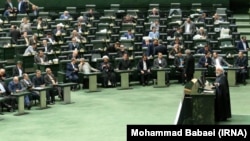In an astonishing move, Iran’s President Hassan Rouhani has presented his administrations’ next year budget to parliament, which is 25 percent higher than the current year, despite tens of billions of dollars in lost oil revenue.
The proposed budget is around $37 billion (based on higher-dollar free-market exchange rate). The current year’s budget, which was already slashed due to the loss of oil revenue, is around $30 billion. Based on the government’s official exchange rate these figures are respectively around $115 billion and $91.5 billion.
The question is how a higher budget can be met, when U.S. oil sanctions remain in place and Iran resorts to spending from its national reserve fund to meet its urgent needs.
In the proposed budget the government hopes to earn about $7.7 billion from exports of oil and oil products, but that is a far cry from the pre-sanction period when Iran’s oil exports could easily reach $60 billion.
The $7.7 billion dollar is based on the higher free market dollar rate, but even if the official exchange rate is considered, the government plans to earn about $24 billion from oil. This is still far below normal earnings, while the proposed budget is 25 percent higher.
Current estimates of Iran’s oil exports are between 200,000-400,000 barrels a day, compared with a pre-sanction high of 2.5 million bpd. If the higher budget is not a political bluster but a realistic figure, it means Iran must sell hundreds of thousands of barrels more oil per day to meet the revenue target. This is highly unlikely, as almost all its customers have already stopped buying Iranian crude and show no appetite to violate U.S. sanctions.
With such a serious revenue shortfall, Rouhani told parliament that Iran is expecting a $5 billion loan from Russia. But such loans are hardly in cash and would probably be designed as credits to pay for imports from Russia.
Reports published in Fars and Tasnim news agencies linked with the hardliner Revolutionary Guards confirm that Iran intends to sell between 870,000 to one million barrels of oil per day. It is true that some gasoline and other refined oil products are unofficially sold overland to Iraq, Pakistan and Afghanistan, but this is a small amount, unlikely to generate the high volumes needed to meet the revenue targets.
But Fars news agency admits that “Considering revenue shortfalls, some of the figures for income simply play the role of presenting a balanced budget and we cannot count for these [revenue] targets to be met”.
The budget also foresees higher revenues from taxes. This also sounds unrealistic for several reasons. First, the economy has shrunk by nine percent this year and it cannot generate more taxes. Second, some of the biggest economic enterprises either enjoy tax-free status or are controlled by powerful regime insiders that can hardly be pushed to pay more. Third, the country faces a volatile situation after bloody protests in November and pressuring ordinary citizens to pay more could amount to political suicide by the ruling establishment.
One of the rare realistic projections in the budget is a 40 percent drop in customs revenues, which corresponds to the economic downturn and reduction in exports and imports due to U.S. sanctions.
If Iran is to meet its budget revenue targets, there is only one realistic course; reduction or suspension of U.S. sanctions on its oil exports. But for that, Iran will have to make some serious concessions on its nuclear and missile programs, and also its role in the region, which prompted the Trump administration sanctions in the first place.







